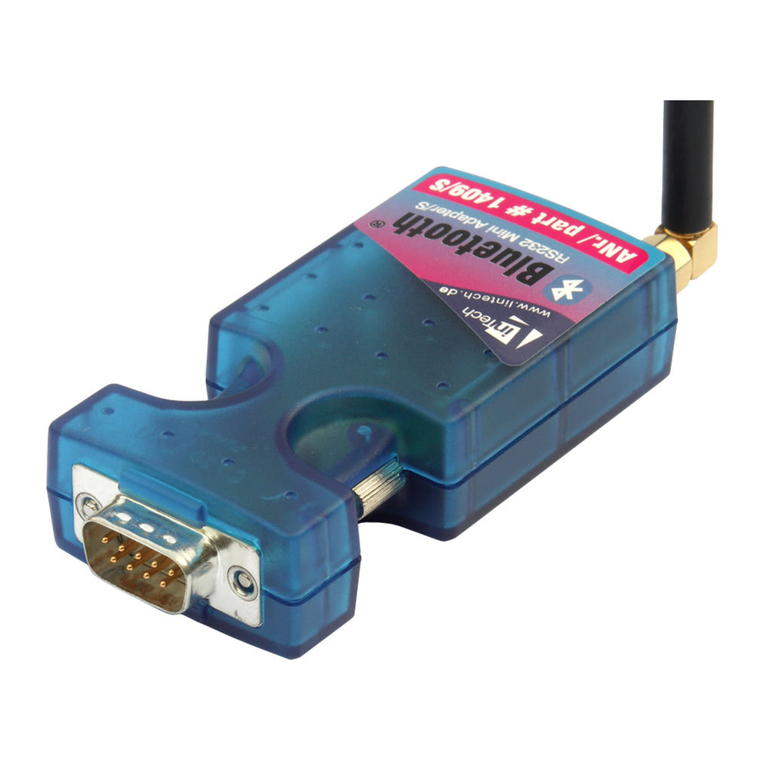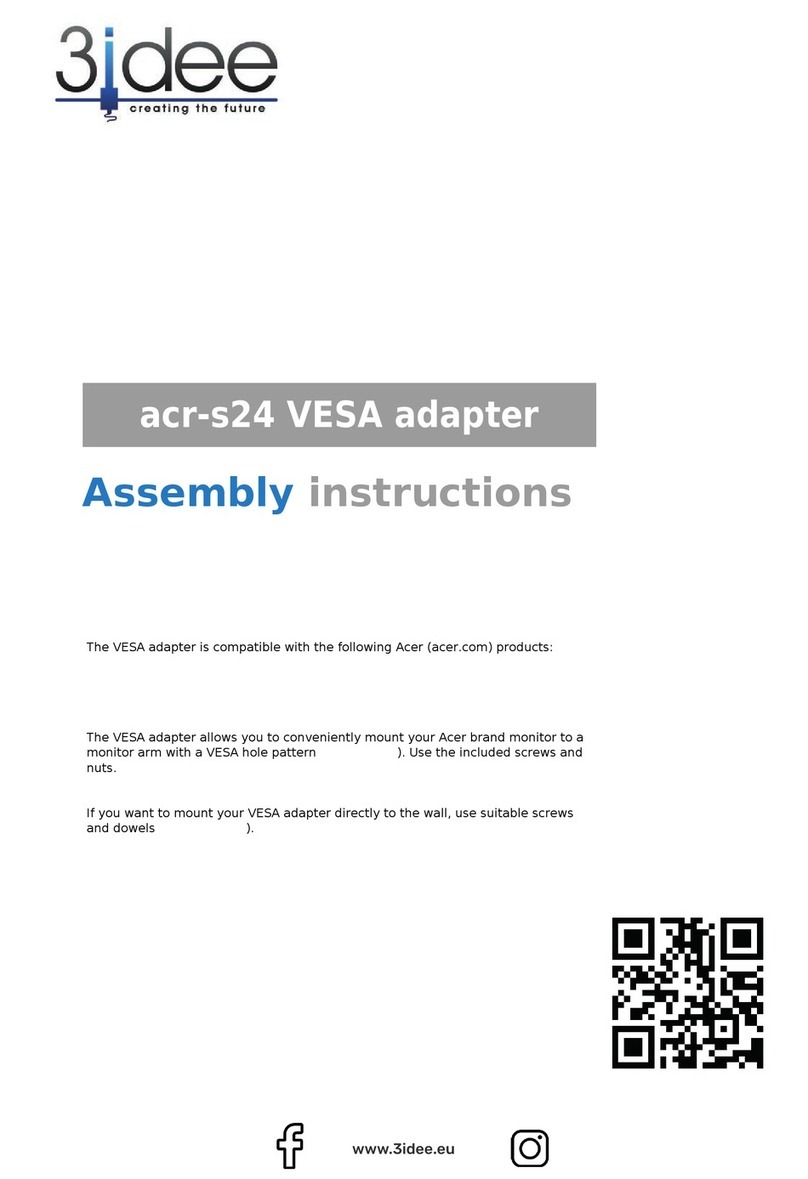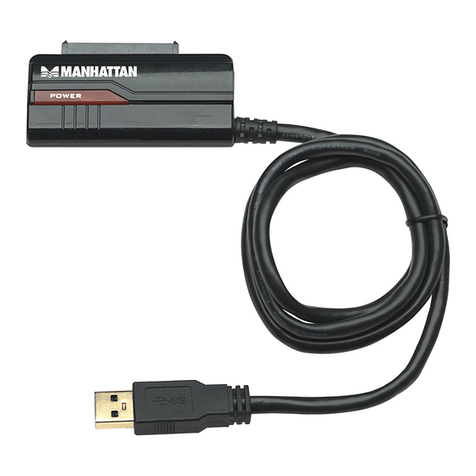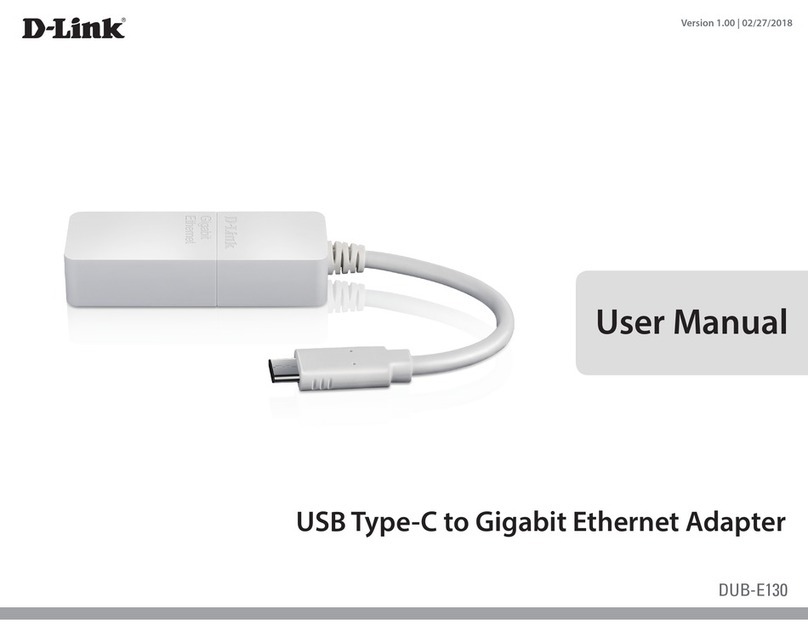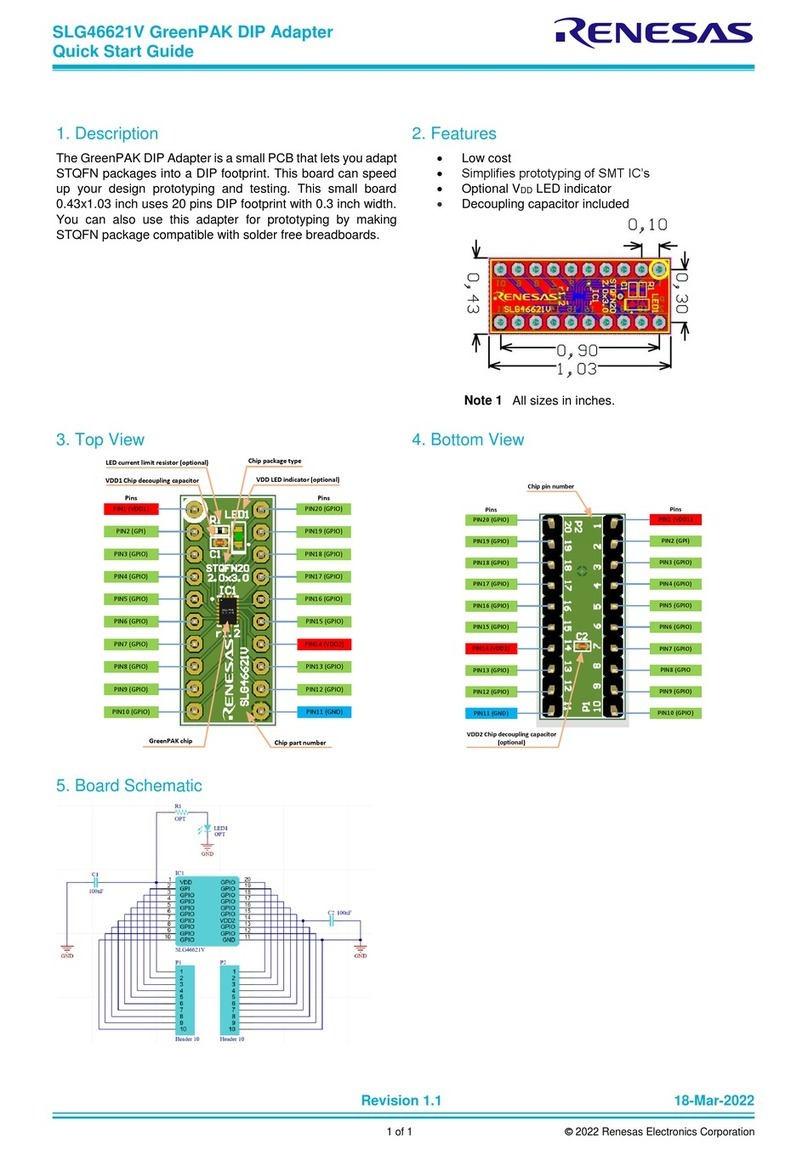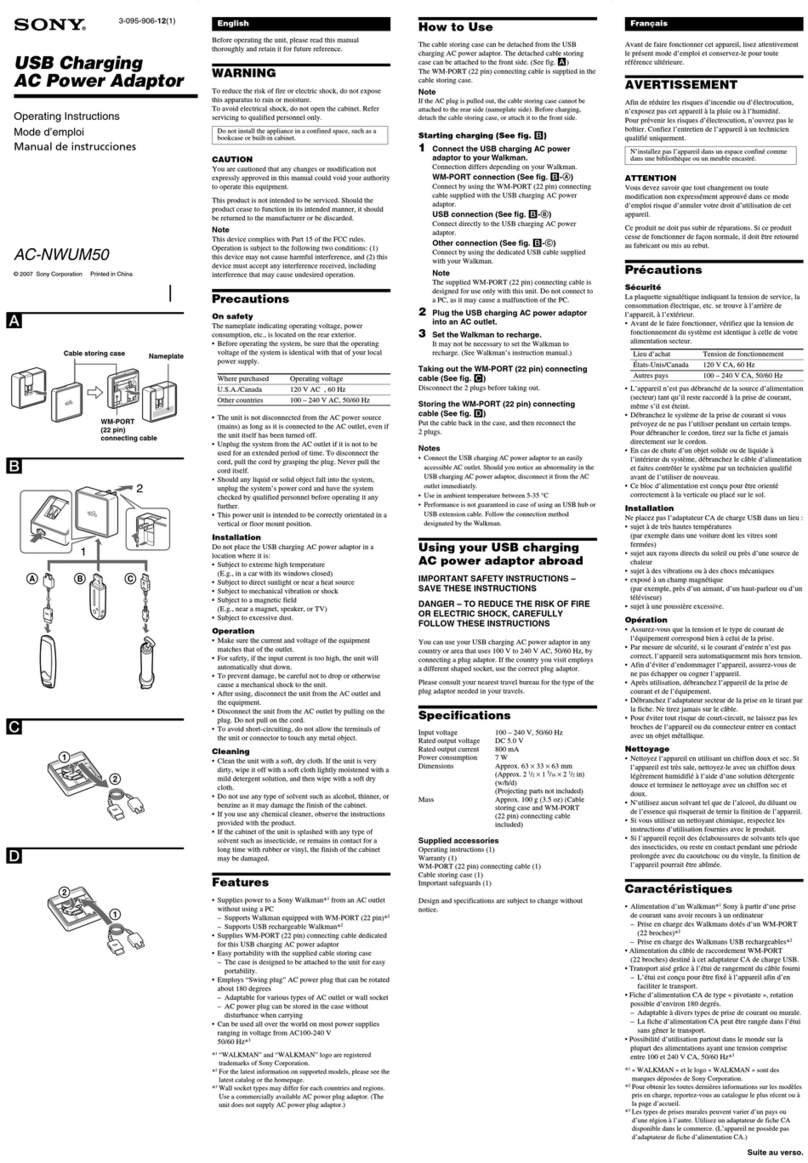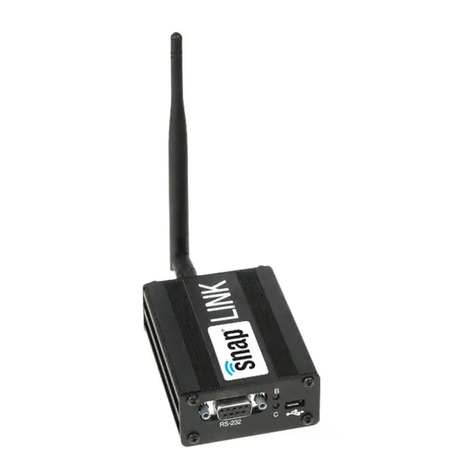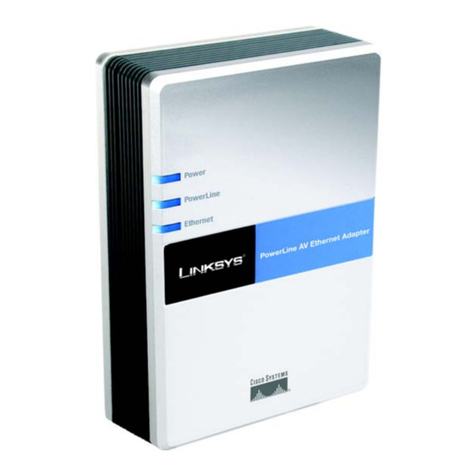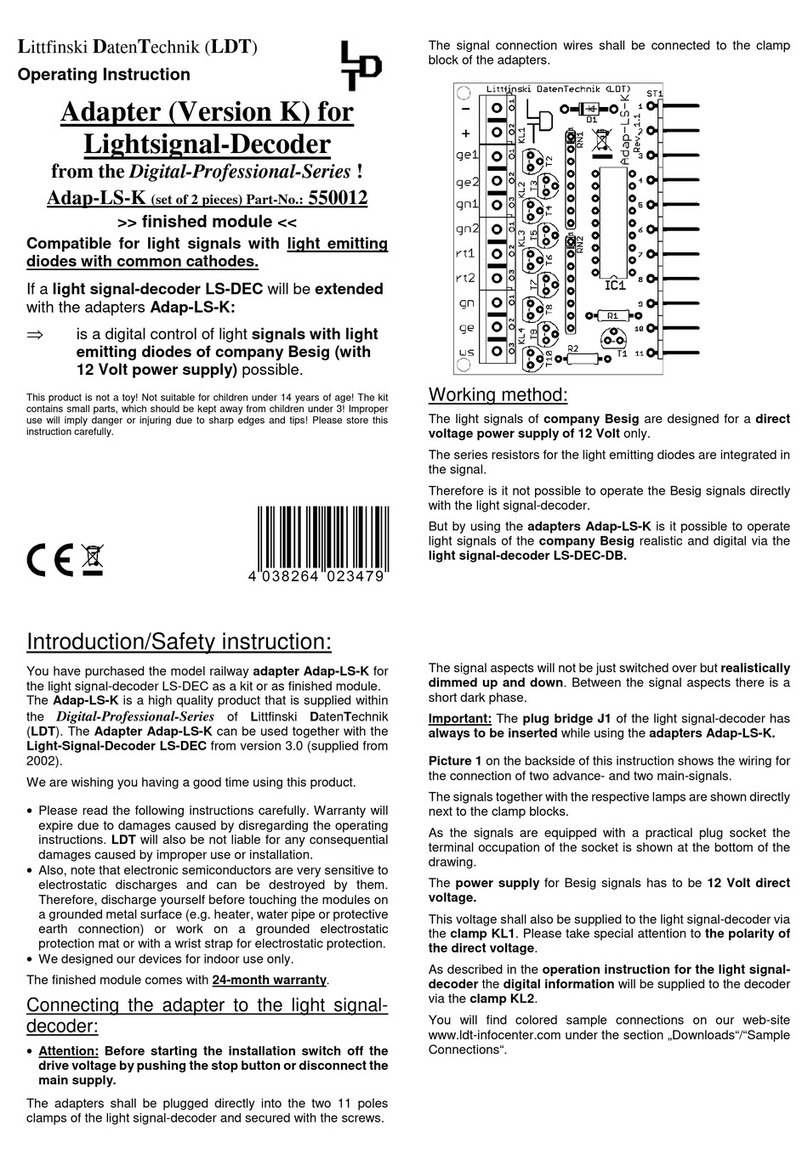Lintech 1409/S User manual

Bluetooth™ RS232 Mini Adapter/S
Article number: 1409/S
Manual

* Bluetooth and the Bluetooth logos are trademarks owned by Bluetooth SIG, Inc., U.S.A. and licensed to LinTech
GmbH, Berlin Germany. 2
CONTENTS
1.INTRODUCTION........................................................................................................................3
1.1. General Description...............................................................................................................................3
1.2. Package Contents.................................................................................................................................4
2. PREPARING FOR USE..............................................................................................................4
2.1 View of adapter......................................................................................................................................4
2.2. Switching on.........................................................................................................................................5
2.3. Charging the battery...............................................................................................................................5
2.4. Switching on for the first time ...................................................................................................................6
2.5. The coupling process for setting up a Bluetooth data connection......................................................................6
2.6. Setting up a connection ..........................................................................................................................8
3. CONFIGURATION.....................................................................................................................8
3.1. Standard settings ..................................................................................................................................9
3.2. Changing between configuration mode and normal operation..........................................................................9
3.3. Connecting to the configuration service ....................................................................................................10
3.4. Connecting to the serial interface of the adapter – configuration using a physical serial interface...........................10
3.5. Configuration using the LinTech BlueTool configuration programme ..............................................................10
3.6. Configuration using AT commands..........................................................................................................11
4. MEANING OF LED2 ................................................................................................................12
5. FIRMWARE UPDATE ..............................................................................................................12
5.1. UpToDate – Software Update Tool for LinTech Bluetooth devices ..................................................................12
5.2. Switching the Bluetooth Adapter to Firmware Download mode.......................................................................13
6. OVERVIEW OF TECHNICAL DATA............................................................................................14
7. AGENCY AND REGULATORY BODY APPROVALS......................................................................15
7.1. Exposure to Radio Frequency Radiation...................................................................................................15
7.2. FCC Part 15 Radio Frequency Interference Statement.................................................................................15
7.3. Industry Canada ICES-003 Emission Compliance Statement.........................................................................15
7.4. European Radio Approval Information......................................................................................................16
7.5. Europe – EU Declaration of Conformity ....................................................................................................16
7.6. Rest of World .....................................................................................................................................16
8. BATTERY STATEMENT – FOR YOUR SAFETY............................................................................17
LIST OF ILLUSTRATIONS
Illustration 1 View of Bluetooth RS232 Mini Adapter/S.....................................................................................4
Illustration 2 Searching for device in the Bluetooth Manager.............................................................................7
Illustration 3 Requesting Bluetooth PIN code..................................................................................................7
Illustration 4 Searching for device ( service COM-HARDWARE).......................................................................8
Illustration 5 Searching for device with the service-ID: COM-CONFIG.............................................................10

* Bluetooth and the Bluetooth logos are trademarks owned by Bluetooth SIG, Inc., U.S.A. and licensed to LinTech
GmbH, Berlin Germany. 3
1.Introduction
1.1. General Description
The Bluetooth RS232 Mini Adapter/S is a Bluetooth* adapter for use with the RS232 serial interface and can be
connected to any piece of equipment displaying this interface.
The adapter is equipped with a high-performance rechargeable battery, so an external power source is not
required. This makes the adapter particularly suitable in mobile applications.
No driver installation is required and the adapter functions fully independently of the operating system platform in
use.
A Bluetooth connection between two devices is always in the form of a Master-Slave connection, i.e. one device
always initiates the connection – this one is the Bluetooth Master device – e.g. PC/ Laptop or PDA with already
integrated Bluetooth interface or with an Bluetooth USB Adapter , Bluetooth PCMCIA or other.
To set up a Bluetooth* connection, you require such a Bluetooth* Master device that supports the Bluetooth*
Serial Port Profile. After start searching for Bluetooth devices you will find LinTech RS232 Mini Adapter. From one
PC/Laptop you can built up connection to only one or to more Bluetooth RS232 Adapters/S´( max. 6 ). – Point-to-
point or Point-to-multipoint- connection.
The Bluetooth RS232 Adapter/S is operational immediately upon switch-on.
An easy-to-use configuration programme is supplied with the adapter with which the user can configure the
connection parameters of the Bluetooth RS232 Mini Adapter/S, such as the baud rate, parity, quantity of data
bits…
For systems which do not operate under the Windows operating system, it is also possible to configure the
adapter using AT commands.
The device is fitted with a high-power LI rechargeable battery. In mobile applications, where power consumption
and operating time are of central importance, an automatic power management function is available, which
switches the device into energy saving mode ('SNIFF' mode). This results in a considerable reduction in power
consumption by the partner device.
A further important feature in this context is that the adapter really becomes operative when a signal is received at
the serial interface. This means that the adapter is only in active mode once the device to which the Bluetooth
RS232 Mini Adapter/S is connected has been switched on.
Our experience has shown that a multitude of requirements are placed on Bluetooth solutions. For this reason,
the Bluetooth RS232 Mini Adapter/S has been conceived to enable its use for a large number of solutions.
If your individual application can not be implemented using the standard functions described in this handbook,
please contact us.

* Bluetooth and the Bluetooth logos are trademarks owned by Bluetooth SIG, Inc., U.S.A. and licensed to LinTech
GmbH, Berlin Germany. 4
1.2. Package Contents
Bluetooth* RS232 Adapter with standardised (male) RS-232 DSUB-9 plug connector
(Optionally available with DSUB-9 connector (female))
Charging unit ( optional available with US/UK/AUS power adapter)
Mini-CD with handbook, AT-command overwiev and configuration software for use with Windows systems
2. Preparing for use
2.1 View of adapter
Illustration 1 View of Bluetooth RS232 Mini Adapter/S
LED1
LED2
USB- jackantenna jack
Key- Operating mode
DC- power jack

* Bluetooth and the Bluetooth logos are trademarks owned by Bluetooth SIG, Inc., U.S.A. and licensed to LinTech
GmbH, Berlin Germany. 5
2.2. Switching on
The standard configuration of the LinTech Bluetooth* RS232 Mini Adapter/S is as follows:
Baud rate : 115200 Bit/s
Stop bit : 1
Parity : None
Data bits : 8
Bluetooth* PIN : 1234
Plug the adapter into the RS232 interface of the device that the RS232 Mini Adapter it is to be operated with.
The Bluetooth RS232 Mini Adapter/S recognises whether or not signals are incoming via the serial interface, i.e.
whether the device is switched on or off.
If the device is switched on, the Bluetooth RS232 Mini Adapter/S changes into operating mode, LED 2 flashes
rapidly for approx. 3 seconds and then slowly green.
( For LED sequences, please sea the overview in section 4.)
If the device is switched off, the Bluetooth Adapter remains in Standby mode.
You can wake up the RS232-interface of the device by typing the push-button of the RS232-adapter, available
from the hardware-version "E". You can activate this function permanently by using AT command: AT+FRS.
Should the RS232 Mini Adapter not switch into operational mode although it is switched on, please charge the
battery.
Please be sure to have the Bluetooth Adapter in use during charging.
2.3. Charging the battery
The Bluetooth RS232 Mini Adapter/S is equipped with a high-performance rechargeable battery, so an external
power source is not required. This makes the adapter particularly suitable in mobile applications.
We recommend charging the batter before using the device for the first time.
Please notify: connect charger first with BT RS232 adapter and afterwards with wall socket.
The battery can be charged either via the Mini- USB port or DC- jack. To avoid overcharging and faulty operation,
always use the battery charger supplied and connect it to the appropriate socket at the rear of the Bluetooth
RS232 Adapter/S (see Ill.1) .
The status of the charging process is indicated by LED1 on the upper surface of the Bluetooth Adapter (see Ill. 1)
LED 1 Meaning
RED
Battery is charging – charge duration to full capacity for empty battery approx. 2 hours
GREEN
Battery fully charged or RS232 Mini Adapter is being powered via the mains supply
OFF
RS232 Mini Adapter is not connected to the power supply

* Bluetooth and the Bluetooth logos are trademarks owned by Bluetooth SIG, Inc., U.S.A. and licensed to LinTech
GmbH, Berlin Germany. 6
2.4. Switching on for the first time
The Bluetooth RS232 Mini Adapter/S is equipped with a high-performance rechargeable battery, so an external
power source is not required. This makes the adapter particularly suitable in mobile applications.
We recommend charging the batter before using the device for the first time (see section 2.3).
The Bluetooth RS232 Adapter/S is operational immediately upon switch-on.
The standard configuration of the LinTech Bluetooth* RS232 Mini Adapter is as follows:
Baud rate : 115200 Bit/s
Stop bit : 1
Parity : None
Data bits : 8
Bluetooth* PIN : 1234
If you want to modify settings, you have to switch the adapter to configuration mode.
The Bluetooth RS232 Mini Adapter /S provides two services/ operating modes: Normal mode and
Configuration mode.
In Normal mode a data connection is set up to the Bluetooth* Adapter; the Configuration mode is used to
configure the settings for the Bluetooth* Adapter either via the Bluetooth connection or the serial interface.
Before the configuration of the Bluetooth connection can be changed, the device must be switched to
configuration mode and a connection must exist to a Bluetooth device (for further information please see the
corresponding section of the manual).
If you want to create a connection from another Bluetooth device to the RS232 Mini Adapter without changing the
configuration, continue as outlined in the following sections.
2.5. The coupling process for setting up a Bluetooth data connection
To set up a Bluetooth* connection, you require a second Bluetooth* Master device that supports the Bluetooth*
Serial Port Profile. Please perform the coupling procedure as outlined in the following.
The first step is to initiate a device search using the Bluetooth* partner device (integrated Bluetooth* circuit, USB
dongle, PCMCIA card, or similar) in the Bluetooth environment.
Here you should find displayed 'LinTech RS232 MINI', indicating that the Bluetooth RS232 Mini Adapter/S has
been found.

* Bluetooth and the Bluetooth logos are trademarks owned by Bluetooth SIG, Inc., U.S.A. and licensed to LinTech
GmbH, Berlin Germany. 7
Illustration 2 Searching for device in the Bluetooth Manager
Now initiate the coupling procedure.
The standard–PIN/ Bluetooth key for the
Bluetooth RS232 Mini Adapter/S is 1234.
Illustration 3 Requesting Bluetooth PIN code
Once the coupling procedure has been completed, the Bluetooth RS232 Mini Adapter/S offers a serial service, by
the name of COM-HARDWARE, using which you can connect the serial interface of the Bluetooth RS232 Mini
Adapter/S with that of your equipment.

* Bluetooth and the Bluetooth logos are trademarks owned by Bluetooth SIG, Inc., U.S.A. and licensed to LinTech
GmbH, Berlin Germany. 8
Illustration 4 Searching for device ( service COM-HARDWARE)
2.6. Setting up a connection
For information on how to establish a connection, please consult the instructions supplied with your Bluetooth
equipment.
In most cases, the Bluetooth environment provides you with virtual COM ports. The Bluetooth* Serial Port Profile
must be allotted to one of these COM ports. It is via this COM port that you communicate with the Bluetooth
RS232 Mini Adapter/S .
3. Configuration
The Bluetooth RS232 Mini Adapter/S can be configured either via an existing Bluetooth connection or via direct
connection to the serial interface of a PC.
In either case, it is first of all necessary to switch the Bluetooth Mini Adapter from normal mode to configuration
mode (see section 3.2.)

* Bluetooth and the Bluetooth logos are trademarks owned by Bluetooth SIG, Inc., U.S.A. and licensed to LinTech
GmbH, Berlin Germany. 9
3.1. Standard settings
The standard configuration of the LinTech Bluetooth* RS232 Mini Adapter is as follows:
Baud rate : 115200 Bit/s
Stop bit : 1
Parity : None
Data bits : 8
Bluetooth* PIN : 1234
An easy to use programme is provided with which you can alter standard settings and also access other features
(such as activating SNIFF mode, connection properties, security settings etc.) via an existing Bluetooth*
connection or the serial interface of the adapter (see BlueTool manual).
For all those applications for which no Windows application is available, it is possible to perform the configuration
by means of AT commands using any available terminal programme (section 3.6).
For configuration purposes, the LinTech RS232 Mini Adapter provides you with a special Bluetooth* service. In
other words, in additional to its normal operational mode, it is possible to use the Bluetooth adapter for
configuration purposes and for changing from one operational mode into this configuration mode.
It is not necessary to remove the Bluetooth adapter from the device with which you are operating it before
performing the configuration.
For information on how to switch between the two modes, please see the following section.
3.2. Changing between configuration mode and normal operation
Press the key on the rear side of the Bluetooth Adapter briefly ( see Ill. 1).
LED2 will then flash continuously for about two seconds, following which LED2 flashes rapidly in short, green
bursts for 3 seconds before changing to slow, short, red bursts.
When LED2 flashes in slow, short, red bursts, it means that the adapter is currently in configuration
mode.
The serial Bluetooth service COM-CONFIG is now available.
If you press the key again for a short time, the Bluetooth adapter will return to normal operation.
(LED2 again flashes continuously, after which LED2 flashes slowly in short green bursts).
When LED2 flashes slowly in short, green bursts, it means that the adapter is currently in normal
operational mode.
The serial Bluetooth service COM-HARDWARE is now available.

* Bluetooth and the Bluetooth logos are trademarks owned by Bluetooth SIG, Inc., U.S.A. and licensed to LinTech
GmbH, Berlin Germany. 10
3.3. Connecting to the configuration service
To be able to configure the Bluetooth RS232 Mini Adapter/S via Bluetooth, it is first necessary connect the
Bluetooth partner device ( Master) with the Bluetooth RS232 Mini Adapter/S configuration service.
To do this, it is necessary to perform a service determination procedure in the Bluetooth manager of the Bluetooth
partner device. The Bluetooth RS232 Mini Adapter/S offers the service COM-CONFIG.
Connect up to this service.
For information on performing this step, please consult the instruction manual received with your Bluetooth
partner device.
Illustration 5 Searching for device with the service-ID: COM-CONFIG
3.4. Connecting to the serial interface of the adapter – configuration using a physical serial interface
Once you have switched the Bluetooth RS232 Mini Adapter/S into configuration mode (section 3.2), plug the
adapter into the serial interface of a personal computer.
3.5. Configuration using the LinTech BlueTool configuration programme
The LinTech RS232 BlueTool is an easy to use Windows configuration programme, with the aid of which you can
perform all the settings required for the Bluetooth RS232 Mini Adapter/S easily and clearly.
Please copy the programme from the cd supplied to a folder on your hard disc, and start the programme from the
hard disc.

* Bluetooth and the Bluetooth logos are trademarks owned by Bluetooth SIG, Inc., U.S.A. and licensed to LinTech
GmbH, Berlin Germany. 11
Before using the BlueTool configuration programme, it is necessary that a Bluetooth connection exists to the
Bluetooth RS232 Mini Adapter/S which uses the configuration service of the Bluetooth RS232 Mini Adapter/S or a
physical connection to a serial interface on your PC.
For further information, please consult the BlueTool manual.
3.6. Configuration using AT commands
In addition to the conventional method of using the BlueTool Windows configuration programme for configuring
the Bluetooth RS232 Mini Adapter/S's connection parameters, it is also possible to perform the settings using AT
commands.
This option is provided due to the fact that not all environments use Windows as an operating system. All that is
required on your RS232 Bluetooth Mini Adapter partner device is a terminal programme, e.g. Hyperterminal.
If you wish to configure the Bluetooth RS232 Mini Adapter/S via an existing Bluetooth connection, the Bluetooth
partner device must be connected to the configuration service of the Bluetooth RS232 Mini Adapter/S.
It is however also possible to configure the adapter using AT commands, by connecting it directly to the serial
interface of a PC.
In either case, the Bluetooth RS232 Mini Adapter/S must be in configuration mode. For switching from normal
mode to configuration mode, please consult the appropriate section of the manual (3.2)
Start the Terminal programme.
Connect the Terminal programme to the virtual Com port to which the COM-CONFIG service of the R232 Mini
Adapter is connected (or to the COM port of the physical interface).
Select the following settings: baud rate 115200 Bit/s, 8 data bits, 1 stop bit, 1 start bit and no parity.
Once the connection has been successfully established, the terminal programme window will display a list of
available AT commands.
Should this listing not be displayed, please enter <ATI2>“ followed by <CR> . This will effect a repeat display of
the available commands.
The respective commands are entered in the terminal window; no echo is produced when the characters are
inputted. All command inputs must be acknowledge by pressing <CR> .
All changes are implemented immediately and saved in the RS232 Mini Adapter.

* Bluetooth and the Bluetooth logos are trademarks owned by Bluetooth SIG, Inc., U.S.A. and licensed to LinTech
GmbH, Berlin Germany. 12
4. Meaning of LED2
LED2 Sequence Meaning
LED flashes green for approx.
3 seconds in short, rapid
bursts
RS232 Mini Adapter begins Slave mode operation
LED flashes green in slow,
short bursts
RS232 Mini Adapter is in normal operating mode – COM-HARDWARE
service is active. Incoming connections are accepted.
LED flashes red in slow short
bursts
RS232 Mini Adapter is in Configuration mode – COM-CONFIG service
is active. Incoming connections are accepted.
LED alternates rapidly
between red and
g
reen
A connection has been successfully established. Sniff mode is not
active.
LED alternates slowly
between red und green
A connection exists. Sniff mode is active.
LED alternates for approx. 2
seconds between red, green
and orange rapidly
The RS232 Mini Adapter button has been pressed.
Press briefly to change between Normal mode and Configuration mode.
OR:
Press continuously to change between Slave and Master mode.
5. Firmware Update
5.1. UpToDate – Software Update Tool for LinTech Bluetooth devices
To download the current firmware version to the RS232 Mini Adapter, please use the UpToDate software update
tool for LinTech Bluetooth devices. For software and firmware updates, please visit www.lintech.de - downloads.
UpToDate supports the following operating systems:
MS Windows NT4.0
MS Windows 2000
MS Windows XP

* Bluetooth and the Bluetooth logos are trademarks owned by Bluetooth SIG, Inc., U.S.A. and licensed to LinTech
GmbH, Berlin Germany. 13
Please consult the programme instructions for information on how to perform a firmware update.
UpToDate functions via the serial interface of the PC to which the Bluetooth RS232 Adapter/S is connected for
the purpose of updating the firmware.
Before using UpToDate it is necessary to set the Bluetooth Adapter to Download mode – this is the only mode in
which a software download can be performed.
The following section explains how to switch the Bluetooth RS232 Mini Adapter/S into Download mode.
5.2. Switching the Bluetooth Adapter to Firmware Download mode
The adapter must be switched off and disconnected from any device.
Press and hold the key and plug the power supply into the adapter.
LED 2 should now light up red – continue to press the key until LED2 changes to green.
The RS232 Mini Adapter is now in Firmware Download mode.
For all other information, please consult the instructions to the UpToDate software update tool for the
Lintech Bluetooth Adapter.
LED2 remains off as long as the Bluetooth RS232 Mini Adapter/S is in Firmware Download mode.
Please note also that the Bluetooth RS232 Mini Adapter/S must be connected via the charger unit for as
long as it is in this mode.

* Bluetooth and the Bluetooth logos are trademarks owned by Bluetooth SIG, Inc., U.S.A. and licensed to LinTech
GmbH, Berlin Germany. 14
6. Overview of technical data
Transmission
frequencies 2.402 GHz to 2.480 GHz
Range Up to 30 m
Bluetooth*
Interface: Supported
Bluetooth*
profiles:
Generic Access Profile
Serial Port Profile
Transmission
power: (class 2) max. 4dBm
Serial interface: RS-232 DSUB-9 plug connector
Baud rate: 1200 Bit/s - 230400 Bit/s
Battery: Lithium-Ion rechargeable battery, 3.7V/540mAh
Standby time up to 10,000 hours
Operating time up 10 hours (115.2 kBit/s)
Charge time: < 2 h
LED1: Status display for battery
LED2: Status display for RS232 Mini Adapter
Casing: ABS translucent blue, dimensions 80x40x18 mm
Weight including antenna and battery: 62 grams
Operating temperature: -30 - +60°C
Charging temperature: 0 – +45 °C
Storage temperature: -30 - +45°C

* Bluetooth and the Bluetooth logos are trademarks owned by Bluetooth SIG, Inc., U.S.A. and licensed to LinTech
GmbH, Berlin Germany. 15
7. Agency and Regulatory Body Approvals
Bluetooth product operating in 2.4GHz band for Home and use.
7.1. Exposure to Radio Frequency Radiation
The radiated output power of the BT RS232 Mini Adaptor 1408/1409 are far below the FCC, Industry Canada and
European Union radio frequency exposure limits. Nevertheless, the wireless radio shall be used in such a manner
that the potential for human contact during normal operation is minimized. The internal wireless radio operates
within guidelines found in radio frequency safety standards and recommendations which reflect the consensus of
the scientific community.
The level of emitted energy emitted is far less than the electromagnetic energy emitted by wireless devices such
as mobile phones. However, the use of wireless radios may be restricted in some situations or environments,
such as aboard airplanes. If you are unsure of restrictions, you are encouraged to ask for authorization before
turning on the wireless radio.
The FCC, Industry Canada and European Union have set a general guideline of 20 cm (8 inches) separation
between the device and the body. This device should be used more than 20 cm (8 inches) from the body when
wireless devices are on.
7.2. FCC Part 15 Radio Frequency Interference Statement
This device complies with Part 15 of the FCC Rules. Operation is subject to the following two conditions:
• This device may not cause harmful interference.
• This device must accept any interference received, including interference that may cause undesired operation.
Note: This equipment has been tested and found to comply with the limits for a Class B digital device, pursuant to
Part 15 of the FCC Rules. These limits are designed to provide reasonable protection against harmful interference
in a residential installation. This equipment generates, uses and can radiate radio frequency energy and, if not
installed and used in accordance with the instructions, may cause harmful interference to radio communications.
However, there is no guarantee that interference will not occur in a particular installation. If this equipment does
cause harmful interference to radio or television reception, which can be determined by turning the equipment off
and on. The user is encouraged to correct the interference by one or more of the following measures:
• Reorient or relocate the receiving antenna.
• Increase the separation between the equipment and the receiver.
• Connect the equipment into an outlet that is on a circuit different from the receiver.
• Consult the dealer or an experienced radio/TV technician for help.
Caution:
Pursuant to Part 15.21 of the FCC Rules for intentional or unintentional radiators, any changes
or modifications not expressly approved by the party responsible for compliance could void the user's
authority to operate this equipment.
7.3. Industry Canada ICES-003 Emission Compliance Statement
This Class B digital apparatus meets the requirement of the Canadian Interference-Causing Equipment
Regulations.
Cet appareil numérique de la classe B respecte toutes les exigences du règlement sur le matériel brouiller du
Canada.

* Bluetooth and the Bluetooth logos are trademarks owned by Bluetooth SIG, Inc., U.S.A. and licensed to LinTech
GmbH, Berlin Germany. 16
7.4. European Radio Approval Information
The BT RS232 Mini Adaptor 1408/1409 are low power, wireless communication devices, operating in the 2.4 GHz
band, intended for home or office use. The power output of this device is well below the RF exposure limits as set
by the European Commission through the R&TTE directive.
The BT RS232 Mini Adaptor 1408/1409 can be operated in the following European Union and European
Economic Area countries:
Austria, Belgium, Cyprus, Czech Republic, Denmark, Estonia, Finland, France, Germany, Greece, Hungary,
Iceland, Ireland, Italy, Latvia, Liechtenstein, Lithuania, Luxembourg, Malta, the Netherlands, Norway, Poland,
Portugal, Slovakia, Slovenia, Spain, Sweden, Switzerland and the United Kingdom.
7.5. Europe – EU Declaration of Conformity
This device complies with the R&TTE Directive 1999/5/EC, and the following standards:
EN 301 489-1
EN 301 489-17 Electromagnetic compatibility and radio
spectrum matters( EMR); Electromagnetic
compatibility (EMC) standard for radio
equipment and services.
ETS 300 328-1:
ETS 300 328-2: Electromagnetic compatibility and radio
spectrum matters (EMR); Wideband
transmission systems; Data transmission
equipment operating in the 2.4 GHz ISM
band and using spread spectrum
modulation technique.
Low voltage Directive (Safety) 73/23/EEC as per:
EN 60950 Safety of information Technology
Equipment
7.6. Rest of World
Country restrictions apply for home and office use.

* Bluetooth and the Bluetooth logos are trademarks owned by Bluetooth SIG, Inc., U.S.A. and licensed to LinTech
GmbH, Berlin Germany. 17
8. Battery statement – for your safety
The 1409 BT Rs232 Adapter is powered by a rechargeable LI-battery.
Temperature extremes can affect the ability of your battery to charge.
Use the battery only for its intended purpose.
Do not leave the adapter with battery in vehicles, directly sunlight, or other places where the temperature may rise
above 60C Do not expose the battery to water or extreme moisture.
Do not drop the battery or subject it to mechanical shocks.
Never use any charger or battery which is damaged..Batteries should be charged in Original manufacturer´s LiIon
specified charging equipment. Use of other chargers may cause excessive heat or even fire.
Charge the battery after purchasing or when it has not been used for a long time before use.
Do not open the adapter. Do not short-circuit the battery.
Batteries has to be replaced by autorized personal only. Caution: Risk of explosion if battery is replaced by an
incorrect type.
Please contact your dealer / manufacturer for get service informations.
Leaving the battery in hot or cold places, such as in a closed car in summer or winter conditions, will
reduce the capacity and lifetime of the battery.
Do not dispose of batteries in a fire!
Dispose of batteries according to local regulations (e.g. recycling). Do not dispose of as household
waste.
This manual suits for next models
4
Table of contents
Other Lintech Adapter manuals
Popular Adapter manuals by other brands

ActionTec
ActionTec USB Wireless Adapter 802UI3(b) user manual
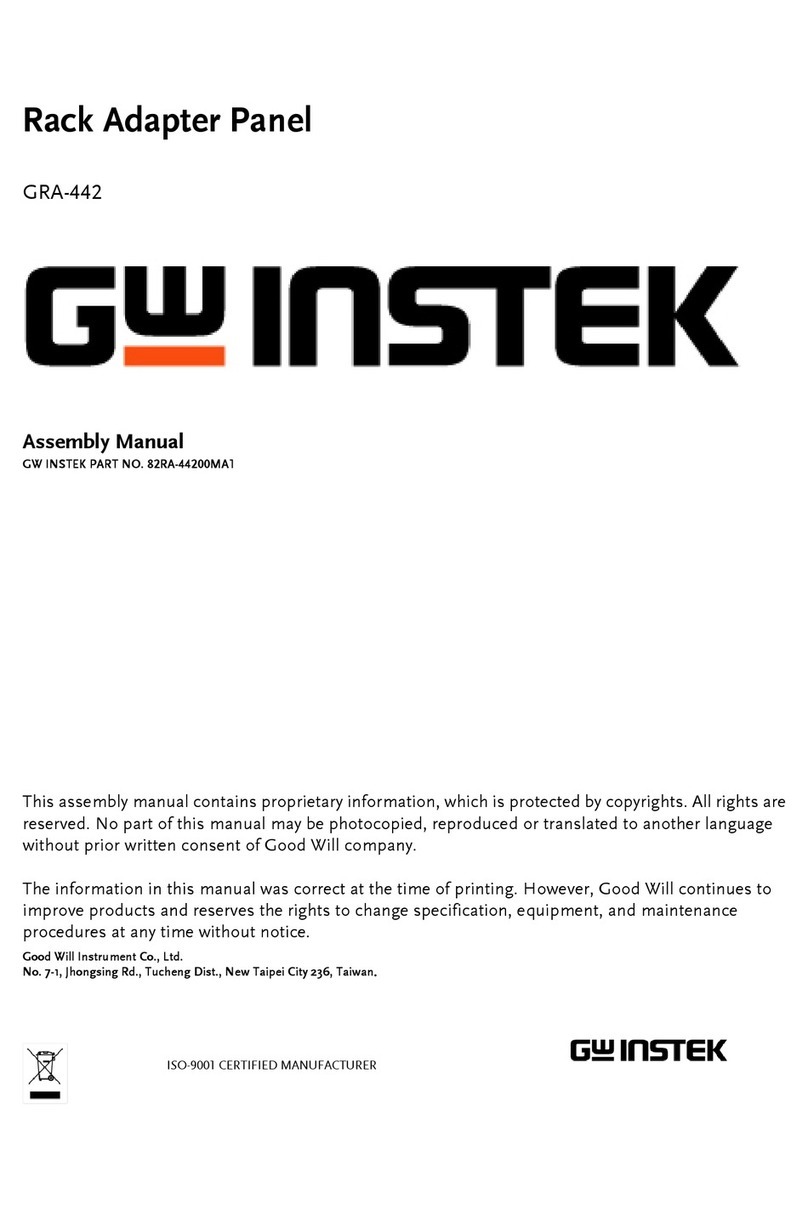
GW Instek
GW Instek GRA-442 Assembly manual

Digital Equipment
Digital Equipment Digital EtherWORKS 3 Turbo User information

Sony
Sony UWA-BR100 operating instructions
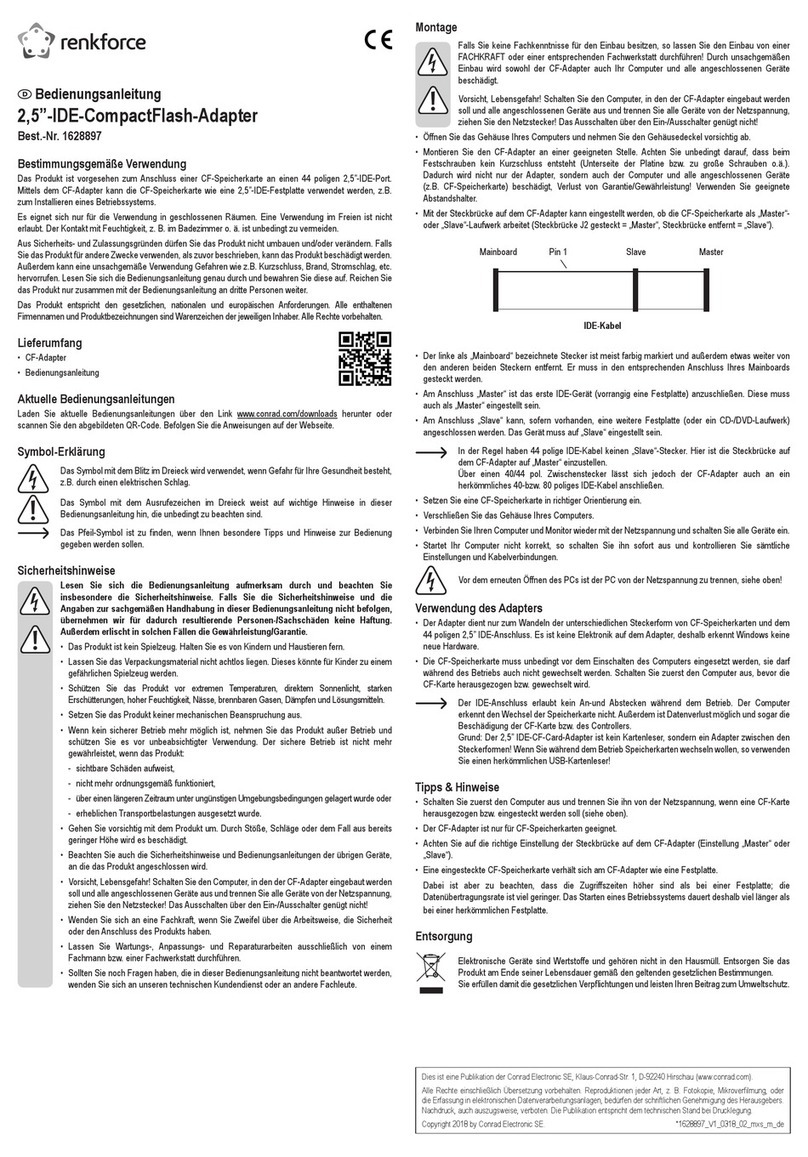
Renkforce
Renkforce 1628897 operating instructions

TP-Link
TP-Link TL-WN823N Quick installation guide
